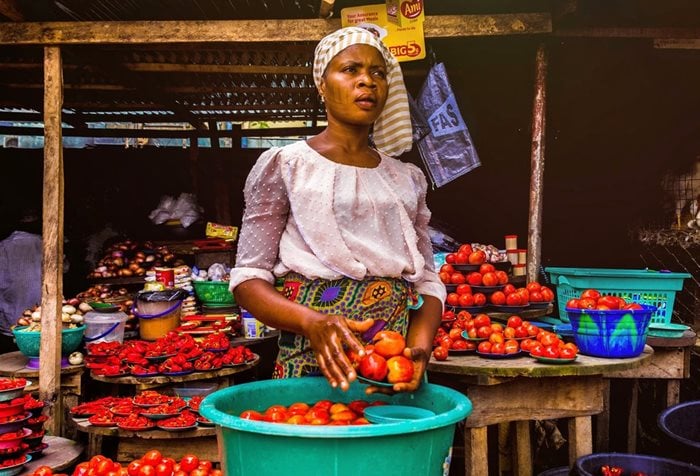The economic contribution of Africa's informal retail market and its prevalence in the lives of the continent's consumers should not be underestimated. Providing underserved communities with convenient access to food and other essentials, informal retail continues to play an important role in the region even as modern channels such as online shopping pick up steam.
As stated in a recent webinar hosted by market research company Euromonitor International, informal retailers remain a preferred shopping destination for billions of consumers in sub-Saharan Africa. We’ve seen greater expansion and ongoing entry of big retail chains in the region, but despite them typically being more organised and having access to more capital, the modern retail channel accounts for just 5% to 30% of total regional retail sales.
Owing to their smaller size and the agility that comes with that, informal retailers - be they street hawkers, open market stalls or informal shops - are ideally positioned to meet their customers where they are and adapt to consumer preferences.
“These retailers can provide convenience and flexibility in terms of operating times, payments, competitive pricing, and personalised service because they know their customers in their community,” said Christy Tawii, research manager at Euromonitor International.
They have the advantage of a small footprint, and are often located close to where customers live or commute, along transport hubs and within local communities. This proximity means traders know their customers intimately. Acting as a “local intelligence mainstation”, they will often stock their shoppers’ preferred brands and can allow flexible credit-based payment plans.
True value unknown
Even though informal retailers are a vital part of the retail system in many African countries, Tawii explained that they tend to remain outside the regulatory framework and don’t comply with imposed reporting standards. And the income generated by informal retailers often falls below the tax threshold in many African countries making compliance difficult to afford.
While legitimate businesses, informal retailers are unregistered or unlicensed. These factors, together with the mobile or temporary nature of their operations, means that the true value of informal retail is difficult to monitor and therefore remains largely unknown.
However, there is data that hints at the magnitude of this channel. “We have industry sources that indicate that, in South Africa for example, the informal food industry generates revenue in excess of R87bn every year,” said Tawii.
She added that data from the International Labour Organisation suggests that informal employment in some countries in the region accounts for more than 80% of total employment, while the contribution of the informal economy towards official GDP exceeds 50% in some sub-Saharan African countries.
“While informal retail customers tend to have low discretionary incomes, their combined purchasing power and contribution to the GDP of a country or region cannot be overlooked,” Tawii noted.
What makes informal retail competitive?
Informal retailers are often the only source of essential goods in communities, and are therefore vital to the economic growth of an area. According to Euromonitor International, outside of South Africa informal retail accounts for 40% to 90% of food sales in many countries in sub-Saharan Africa.
Tawii likened informal outlets to convenience stores, and shared that in Nigeria, the average informal retail store is located within a 500-metre radius of 100 households.
It’s not only the selling of essentials that attract shoppers, but the availability of indigenous and culturally relevant foods and other goods. “In the South African context, you’ll likely find mogodu and mopani worms in an informal store instead of a mainstream supermarket. That’s what makes these stores attractive as they’re selling products modern channels don’t offer,” Tawii said.
The informal trader’s role can extend beyond purely selling goods, as they can serve as important distribution points for services. In the case of payments and remittances, Tawii noted that Kenya’s innovative mobile payment system M-Pesa often relied on informal retailers to be agents, who then played a significant role in driving adoption of the service.
What brands need to know
So, what must brands understand about the informal retail channel to get their products to this market successfully? The foundation, according to Tawii, is to have a grasp on who informal retail consumers are and how products need to be designed for the informal channel.
Tawii noted that we need to dispel the myth that only low-income consumers shop at informal retailers. “The informal channel serves consumers at all income levels, in rural and urban environments, especially when considering that penetration of modern retail in the region remains limited,” she said.
Informal traders remain attractive due to their convenient locations, operating times, payment flexibility, personalised service, unique product offering and competitive pricing.
Affordability is a cornerstone of the informal business model. Informal retailers achieve price competitiveness by repackaging and bulk breaking products into smaller portions and affordable unit prices that are appealing to cash-constrained consumers, sometimes selling a single teabag, egg or nappy.
Traders will also often sell small packets of snacks, particularly at transport hubs, to attract impulse purchases.
“Companies can learn from this when expanding or selling in the African informal market. It’s not only the distribution strategy that must be taken into account but also the packaging format and size of the product,” Tawii said.
She also encouraged brands to find ways to help bridge some of the challenges that informal traders face, which can help brands grow market share in the channel.
Among the challenges are that many informal retailers in sub-Saharan Africa lack refrigeration facilities and/or reliable access to electricity, so frozen and chilled foods are rarely sold. In addition, traders’ inventories are dependent on limited capital, and they therefore require affordable selling space and easy access to supplies.
Integrated approach necessary
“For any consumer brand or retailer seeking to enter the African market, where informality is prevalent, they need to go beyond modern retailing to succeed. This means having an integrated approach to entering the market, which should take into account both formal and informal retailing,” Tawii said.
She urged brands to connect with the right partner throughout the retail value chain. “When considering the complexity of the retail landscape in Africa, last mile distribution through intermediaries can be a viable means of reaching an underserved population. It’s essential to come up with innovative distribution models for the sub-Saharan Africa consumer, particularly those at the bottom of the pyramid.”
“Understand that a one-size-fits-all approach will not work in Africa as the market is so complex. Each country is unique with diverse consumers … But the informal market represents where most Africans typically shop. It’s here to stay and it’s not going away anytime soon,” Tawii said.




























